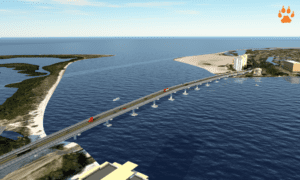By: Kara Tyler-Julian
For those of us who grew up in Florida and spent much time outdoors, the gopher tortoise is a familiar sight, like an old friend you can instantly reconnect with every time you see them. Thanks to its slow speed and conspicuous burrows, it is one of the few native wild animals that people can observe up close and for a decent length when you can find one out of its burrow on a foraging mission.
Like the hobbits in the Lord of The Rings novels, gopher tortoises are shy creatures that prefer a quiet life of solitude. When they aren’t out foraging on native grasses and other plants, they spend much time in their burrows underground. Gopher Tortoises maintain a very small home range (just a few hundred feet), and outside of their short breeding season, they aren’t interested in adventures.
Gopher tortoises, scientifically named Gopherus polyphemus, are a keystone species due to their habit of creating these cozy underground burrows. The term keystone species refers to the fact that the burrows made by these tortoises also provide shelter for around 360 other native animal species. Some species sharing the burrows of gopher tortoises include the threatened indigo snake, the Florida mouse, and the gopher cricket. The tortoises can construct these burrows thanks to their shovel-like front legs. These reptilian engineers seem to be smarter than many humans in that they choose to build their burrows in upland habitats with dry, sandy soils. This selection of dry upland habitats means that their burrows, which average 6.5 feet deep according to the Florida Fish and Wildlife Conservation Commission (FWC), stay dry even in the rainy season.
Unfortunately, this evolutionarily beneficial habitat choice has also contributed to the greatest threat to gopher tortoise populations: habitat loss. As the population in Florida is surging with mass relocation to our state of people from Northern and Western states, the development of vacant land in dry upland habitats has experienced a sharp increase. This results in gopher tortoises being displaced and actively entombed in their burrows daily as bulldozers can flatten a once-pristine quarter-acre lot of mature slash pines and saw palmettos in a matter of hours.
As the gopher tortoises are a threatened species, there are state laws in place that are meant to protect them from harm. One of these laws requires anyone planning any construction or land-clearing activity to obtain a permit to relocate the gopher tortoises before commencing any such activity within 25 feet of an active tortoise burrow. However, no local laws require a permit to be obtained or a wildlife survey conducted before such activities on any land less than 5 acres in size. As there is no need to obtain a permit or conduct a wildlife survey before clearing these lots, there is also no incentive for people to do their due diligence to ensure that they aren’t harming wildlife when clearing lots. Indeed, there is instead a disincentive as they would have to conduct the surveys themselves. Upon finding active tortoise burrows, they would need to apply for a relocation permit with FWC and pay thousands of dollars in fees.
Every day, dozens, if not hundreds, of quarter-acre lots of pristine upland habitats are bulldozed in Lehigh Acres and Alva to make way for new houses to be built. Anyone driving through these areas knows gopher tortoises are common throughout these vacant lots. Yet, a search of the FWC gopher tortoise permit map reveals 0 permits in Lehigh Acres and Alva. It is highly unlikely that none of the cleared lots has gopher tortoise burrows. Instead, it is far more likely that none of these developers are following the law and obtaining the proper permits to relocate gopher tortoises before commencing the clearing and construction. This clash of increased development moving at record speed in the upland habitat of this slow-to-reproduce native reptile has deadly consequences for these tortoises. It threatens our local populations and other species of native wildlife. A straightforward solution to this problem would be for our county commissioners to write local ordinances requiring permits before clearing vegetation on all lots in Lee County, regardless of size (eliminating the 5-acre minimum). Before obtaining the permit, they should need a wildlife survey by a third-party biologist. If the biologist determines that active gopher tortoise burrows are present, they could ensure that the developer obtains the proper relocation permits from FWC before the clearing activity.
The only downside to this requirement would be to the developers, who could no longer get away with the mass destruction of gopher tortoise burrows and would have to spend more money and time than they currently do to clear lots. It would be a big win for the gopher tortoises and the 360 species that depend on them. However, the relocation process could be better and still leads to some mortality in the gopher tortoises.
April 10th has officially been adopted by the Gopher Tortoise Council as Gopher Tortoise Day, and the members of East Lee Wildlife Stewardship Group invite you to join us in celebrating this ancient and enigmatic reptile. You can join an evening for the tortoises at Calusa Nature Center on April 10th. In addition to celebrating the gopher tortoises on April 10th, you can help support the gopher tortoises year-round in many other ways. To provide food and habitat for gopher tortoises, try planting native plants and turning your yard into a gopher-tortoise-friendly one. Spread awareness for gopher tortoises and their plight by sharing information with friends and neighbors about these creatures and the threats that they face. If you have the resources, consider purchasing some of the vacant lots in tortoise habitat and preserving them for the tortoises. If you live near tortoise burrows, keep an eye on them, and if you see that they are in danger of being bulldozed, call the FWC wildlife alert hotline at 888-404-3922. Lastly, and perhaps most importantly, advocate for strengthening local ordinances regarding land-clearing activities to ensure proper steps are taken to protect gopher tortoises on vacant lots. Please help us be a voice for the voiceless and protect our unique native wildlife.








